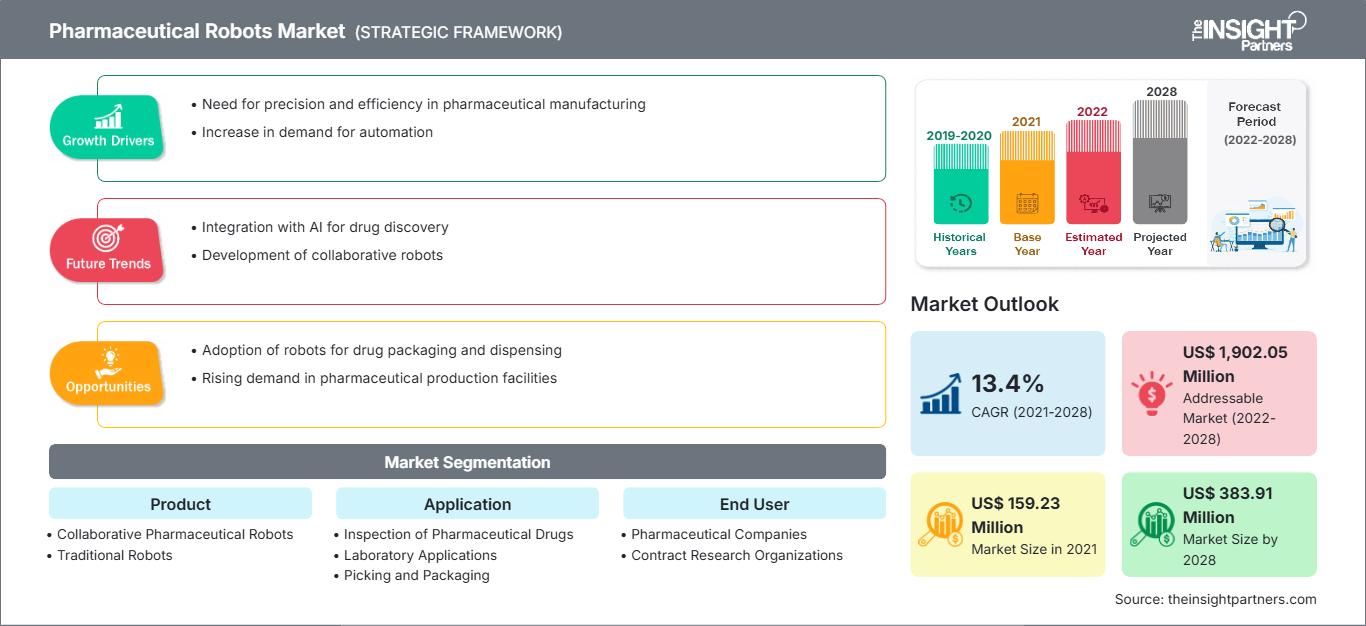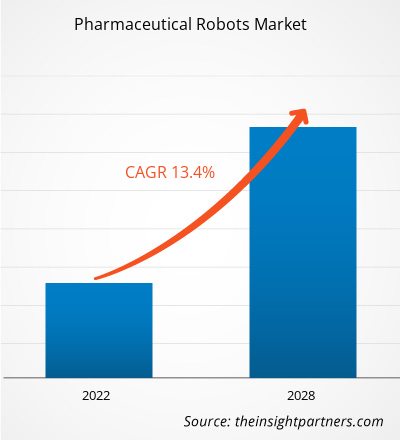[調査レポート]製薬ロボット市場は、2021年の1億5,923万米ドルから2028年には3億8,391万米ドルに達すると予測されており、2021年から2028年にかけて13.4%のCAGRで成長すると見込まれています。
製薬業界では、医薬品の製造において効率的で精密な精度が求められています。そのため、医薬品製造にロボットを使用すると、品質が向上し、コストと時間が削減されます。ロボットは、充填、検査、包装、実験、パーソナライズされた医薬品の製造において有利であることが証明されています。ロボットシステムとは、複数の動作軸を持ち、あらゆる機能を実行するようにプログラムできる自動化の一種です。
このレポートでは、市場動向、技術の進歩、市場ダイナミクス、世界中の主要市場プレーヤーの競合状況分析など、さまざまなパラメータに重点を置いて、製薬ロボット市場の洞察と詳細な分析を提供しています。また、COVID-19パンデミックが全地域に及ぼした市場への影響も含まれています。パンデミックの影響と世界的な研究活動の減少は、製薬ロボット市場における複数の企業の事業運営と財務状況にも悪影響を及ぼしています。国際獣疫事務局(OIE)は、進行中の研究やCOVID-19が動物の健康と家禽の公衆衛生に及ぼすその他の影響に関する研究を支援しています。また、リスク評価、リスク管理、リスクコミュニケーションにも貢献しています。OIEはこれらの活動を調整するためにインシデント調整システムを導入しています。さらに、COVID-19パンデミックとそれに伴うロックダウンは、世界各国の畜産・家禽部門に大きな影響を与えています。市場チェーンの開放と、地方自治体による配送システムのボトルネック解消に向けた追加措置により、需給ギャップは徐々に縮小していることが分かっています。さらに、この影響は長期にわたると予想され、畜産・家禽部門の生活、雇用、そして経済全体に大きな影響を与えることが予想されます。製薬ロボット市場は、投与量、疾患、技術、地域に基づいてセグメント化されています。地域別には、北米、ヨーロッパ、アジア太平洋、中東・アフリカ、中南米に区分されています。
市場インサイト
要件に合わせてレポートをカスタマイズ
レポートの一部、国レベルの分析、Excelデータパックなどを含め、スタートアップ&大学向けに特別オファーや割引もご利用いただけます(無償)
製薬ロボット市場: 戦略的洞察

-
このレポートの主要な市場動向を入手してください。この無料サンプルには、市場動向から見積もりや予測に至るまでのデータ分析が含まれます。
クラウドロボティクスは、クラウドコンピューティング、クラウドストレージ、その他のインターネット技術を基盤とし、統合インフラストラクチャと共有サービスの利点を軸としたロボティクスの新興分野です。ロボットをクラウドに接続することで、計算能力、ストレージ、通信能力が向上します。クラウドロボットは互いに通信することで、容易に操作を実行できます。
Google Cloud Robotics Platformは、AI、ロボティクス、クラウドを組み合わせ、クラウド接続された協働ロボットを活用した自動化ソリューションのエコシステムを実現します。AIや機械学習サービスと組み合わせることで、ロボットは製造業の高度に動的な環境において、プロセスを効率的に実行できるようになります。さらに、製造業においてクラウドは大量のデータ処理の強力な味方です。例えば、バイオ医薬品企業のExscientiaとCelgeneは、2019年にがんや自己免疫疾患の治療薬の発見を加速させるため、1,964万ユーロの契約を発表しました。 2020年には、COVID-19の治療薬候補を見つけるため、他社との提携も発表しました。その結果、同社は現在、ヒトでの試験に成功した薬剤やその他の化学物質を含む分子パッケージへのアクセスを獲得しています。同社は、ウイルスに対抗できる可能性のある薬剤のリストを精査するつもりでした。Exscientiaの技術は大規模なデータベースを精査し、どの化合物が副作用を起こさないかを正確に予測することで、目的を達成することができます。同様に、2020年には、別の製薬会社であるベーリンガーインゲルハイムがバイオテクノロジー企業のClick Therapeuticsと提携し、5億ドル規模のデジタル治療薬を開発しました。より正確には、両社は認知機能障害のある統合失調症患者を支援するためのモバイルアプリケーションの開発と配信で協力する計画を立てていました。また、IBMは、AI、クラウドコンピューティング、ロボティクスを駆使して研究者の自宅から医薬品を開発できる化学実験室RoboRXNを開発しました。
適切なセキュリティプロトコルを備えたクラウドベースのソフトウェアは、統合と自動化を促進するために採用できます。これにより、企業の書類作業が削減され、データが管理しやすくなります。そのため、クラウドロボティクスは今後、製薬ロボット市場のトレンドになると予想されています。
製品ベースの洞察
製品に基づいて、製薬ロボット市場は協働型製薬ロボットと従来型ロボットに分類されます。2021年には、協働型製薬ロボットセグメントが最大の市場シェアを占めると推定される一方、従来型ロボットは予測期間中に市場で最も高いCAGRを記録すると予想されています。このセグメントの成長は、調剤、仕分け、キット組み立て、軽作業の機械操作に加え、包装などの従来の用途でもロボットの利用が増加していることに起因しています。
アプリケーションベースの洞察
アプリケーションに基づいて、製薬ロボット市場は、医薬品検査、実験室アプリケーション、ピッキングおよび包装に分類されます。医薬品検査セグメントは2021年に市場で最大のシェアを占め、予測期間中に市場で最も高いCAGRを記録すると予測されています。
エンドユーザーベースの洞察
エンドユーザーに基づいて、製薬ロボット市場は、製薬会社、研究室、および契約研究機関に分類されます。製薬会社セグメントは2021年に市場で最大のシェアを占める一方、研究室セグメントは予測期間中に市場で最も高いCAGRを記録すると予測されています
製薬ロボット市場のプレーヤーは、製品の発売や拡張などの有機的な戦略を採用して、世界中でフットプリントと製品ポートフォリオを拡大し、高まる需要に対応しています。
製薬ロボット市場の地域別分析
予測期間を通じて医薬品ロボット市場に影響を与える地域的な動向と要因については、The Insight Partnersのアナリストが詳細に解説しています。このセクションでは、医薬品ロボット市場のセグメントと地域についても、北米、ヨーロッパ、アジア太平洋、中東・アフリカ、中南米に分けて解説しています。
製薬ロボット市場レポートの範囲
| レポート属性 | 詳細 |
|---|---|
| の市場規模 2021 | US$ 159.23 Million |
| 市場規模別 2028 | US$ 383.91 Million |
| 世界的なCAGR (2021 - 2028) | 13.4% |
| 過去データ | 2019-2020 |
| 予測期間 | 2022-2028 |
| 対象セグメント |
By 製品
|
| 対象地域と国 |
北米
|
| 市場リーダーと主要企業の概要 |
|
製薬ロボット市場におけるプレーヤーの密度:ビジネスダイナミクスへの影響を理解する
医薬品ロボット市場は、消費者の嗜好の変化、技術の進歩、製品メリットへの認知度の高まりといった要因によるエンドユーザーの需要増加に牽引され、急速に成長しています。需要の増加に伴い、企業は製品ラインナップの拡充、消費者ニーズへの対応のためのイノベーション、そして新たなトレンドの活用を進めており、これが市場の成長をさらに加速させています。

- 入手 製薬ロボット市場 主要プレーヤーの概要
- 協働型製薬ロボット
- 従来型ロボット
- デルタロボット
- 多関節ロボット
- 直交ロボット
- スカラロボット
- その他
用途別
- 医薬品検査
- 研究室用途
- ピッキングと梱包
エンドユーザー別
- 製薬会社
- 研究機関
- 契約研究機関
別
地理
-
北部アメリカ
- 米国
- カナダ
- メキシコ
-
ヨーロッパ
- フランス
- ドイツ
- イタリア
- 英国
- スペイン
- その他のヨーロッパ
-
アジア太平洋 (APAC)
- 中国
- インド
- 韓国
- 日本
- オーストラリア
- その他の APAC
-
中東 &アフリカ(MEA)
- 南アフリカ
- サウジアラビア
- UAE
- MEAのその他の地域
-
中南米(SCAM)
- ブラジル
- アルゼンチン
- SCAMのその他の地域
企業プロフィール
- ABB Ltd.
- 川崎重工業株式会社
- 安川電機株式会社
- Universal Robots A/S
- Marchesini Group SpA
- デンソー株式会社
- ファナック株式会社
- Espon India Pvt. Ltd.
- 株式会社渋谷
- Weiss GmbH
- 過去2年間の分析、基準年、CAGRによる予測(7年間)
- PEST分析とSWOT分析
- 市場規模価値/数量 - 世界、地域、国
- 業界と競争環境
- Excel データセット
最新レポート
関連レポート
お客様の声
購入理由
- 情報に基づいた意思決定
- 市場動向の理解
- 競合分析
- 顧客インサイト
- 市場予測
- リスク軽減
- 戦略計画
- 投資の正当性
- 新興市場の特定
- マーケティング戦略の強化
- 業務効率の向上
- 規制動向への対応






















 無料サンプルを入手 - 製薬ロボット市場
無料サンプルを入手 - 製薬ロボット市場